Renaissance Art & Ancient Alien Theory
During the Renaissance period prior to the French Revolution, mysterious elements have been discovered in several paintings by different artists. It's important to note some of these paintings have been fully explained by religious organizations and proved to not have any extraterrestrial influence. Certain elements to pay attention in this scenario include the Cardinal hat portrayed as an unidentified flying object, a satellite which is actually an interpretation of the universe creation sphere, the dove, actually representative of the Holy Spirit, and light type elements speculated to be associated with the disc shaped alien objects. As true art should be, interpretation relies solely on the interpreter. Personal beliefs, values and impressions may skew artwork far from the true intended message. The following artworks have been referred to by ancient alien theorists to have significant value to the overall theory, which encompasses a very large array of disciplines, and is not stringent upon the content of any one specific art piece.
Baptism of Christ - Aert De Gelder - 1710
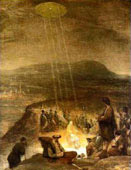
Baptism of Christ (Fg. 1-4a)
A very intriguing art piece in a series from De Gelder, this one displays the Baptism of Christ and presents quite a few questions regarding the composition. Aert studied under Rembrandt, was considered to his brightest student, and most avid follower. Rembrandt's influence seems to be the only solid theory as to why De Gelder painted original elements into his works that do not transcend with other artists during the period. This specific piece displays a circular formation in the sky with several rays of light shining upon Jesus, however, the circle is not composed of a series of cherubs, nor is the dove or Holy Spirit traditionally portrayed. Though the composition doesn't seem to follow the common traditions depicted by other artists, it does not necessarily mean Aert's message isn't one in the same. Part of being a good artist is being unique.
Glorification of the Eucharist - 1600 - Bonaventura Salimbeni

Eucharist (Fg. 1-4b)
Though this painting is representative of a creation sphere meant to depict the universe as a whole, and the Holy Trinity, certain intriguing aspects still remain. Jesus and the Father are holding wands which may give the impression of Sputnik as some have written about, though we know this to be highly unlikely. Some researchers have even suggested Sputnik may have been modeled after Salimbeni's work. Another interesting aspect of the painting is where Jesus and the Father are pointing and why. Given the grip on the wands in a penmanship-like fashion, the impression is one of precision as markings found throughout the artwork. It may also indicate the position which Jesus and the Father hold in the heavens, over the creation of Earth.
The Madonna with Saint Giovannino - Domenico Ghirlandaio
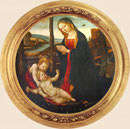
Saint Giovannino (Fg. 1-4c)
A puzzling object found in the top right corner of this painting has the striking resemblance of a modern unidentified flying object, and mystery deepens when examining the painting just below the intentionally placed object. We notice a man and his dog looking upward at what appears to be a mysterious flying craft - They are standing faintly on the shoreline near Madonna's left shoulder, with one hand up to block the light. A magnified view of the object does appear like modern alien craft depictions although it is quite possible this subtle touch by Ghirlandaio was designed to further emphasize the presence of the Holy Spirit during the sacred conversation.
The Annunciation with Saint Emidius - 1486 - Carlo Crivelli
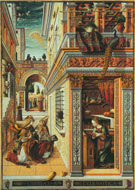
Annunciation (Fg. 1-4d)
Displays a ray of light emanating from a disc shaped cloud formation in the sky directing through an opening in the building, to the Dove, to Mary. The area of interest isn't necessarily the circular cloud disc of cherubs in the sky and beam of light which may seem odd to some. Common accouterments found in an alchemist's study where Mary is located is what rises questioning. The painting's period was during a time when Alchemy was viewed to be deceptive and banned from practice for 200 years by Pope John XXII, King Charles V, King Henry IV, King Henry VI and both the cities of Venice and Nuremberg. Pope Sixtus IV granted the town of Ascoli a degree of self-government and this painting was the altarpiece for the church of SS Annunziata. Does this depict Mary embracing the liberty of Ascoli by visiting the local Alchemist?
Visoki Decani Monastery ~1350

Decani Monastery (Fg. 1-4e)
Located in the Serbian province of Kosovo, the beautiful Visoki Decani Monastery is well decorated and home to several period relics of the saints. including the entire preserved body of St. King Stefan of Decani. Among the many frescoes, one stands alone in describing the crucifixion of Christ. In each of the top corners is what appears to be a flying craft with a human figure inside.
Dust of Apricot, Utsuro-bune 1803
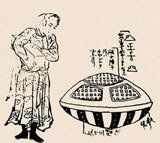
Ume No Chiri (Fg. 1-4f)
In 1803 a completely foreign ship and crew washed upon the shore of Japan's eastern coast some versions contend the ship landed in Minato Bōshū and Harato-no-hama. The 1844 book, Ume No Chiri contains an entry describing a completely foreign ship and crew, witnessed at Hratonohama in Hitachi no Kuni. Dust of Apricot is not the only text with references to Utsuro-bune, or the Hollow Ship. It also appears in Toen shōsetsu 1825, and Hyōryū kishū in 1835 prior to Ume No Chiri's publication. The mysterious craft is reported to be built from iron and red sandalwood with glass and crystal fit windows. Glyphs from an unknown language decorated the inside. This encounter proceeds to describe a young woman who spoke a foreign language leaving the ship, holding a wooden box.
Annales Laurissenses - 776 (Before Renaissance)
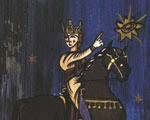
Laurissenses (Fg. 1-4g)
Several scholars have claimed the two Laurissenses images circulating online, supposedly extracted from an Annales manuscript as faked, but it does not explain the actual text documented at the time. In the Maiores (MGH SRG 6) on page 44 there is the mysterious 776 passage which talks directly of the watchmen witnessing two large, reddish-colored flaming shields moving above the church the very moment the Saxons were preparing to attack the Christians living in the castle once again. The script specifically refers to large flaming shields as the manifestation of God directly above the church.
Miracle of the Snow - 1432 - Masolino Da Panicale
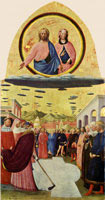
Hill Church (Fg. 1-4h)
Painted to honor the foundation of Santa Maria Maggiore, the Miracle of the Snow is based on a legend from the year 352 when Pope Liberius and Giovanni had a dream of Mother Mary asking to have a church built on one of the seven hills of Rome. She also told them in the marked location it would snow as depicted in the later painting. According to the legend, it snowed in an exact square where claimed and the first church in honor of Mother Mary was built in place. Miracle of the Snow mysteries are also linked to an event in 1954 over Florence Italy where it was reported several flying discs left a cotton-like discharge as they flew by. Shapes of clouds in Panicale's painting are not the normal designs found in other paintings during the period which leaves some speculation to their true meaning. Perhaps Masolino recognized the importance of Mother Mary's request enough to create a memorable piece outside of traditional elements at the time in order to honor her and the event.
† Article 1-4
